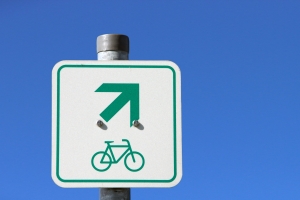- Increases in observed ridership within one year of protected bike lanes' construction ranged from +21% to +171%
- Increases appeared to be greater than overall increases in bicycle commuting in each city
- Increases were made up of 11% new riders, or riders who would not have traveled by bike without the protected lane, and 89% riders who took the route because of the new lane, but would have biked anyway
- 96% of interviewed cyclists felt that the protected lane increased the safety of bicycling on the street
- 79% of residents interviewed felt that the protected lane increased the safety of bicycling on the street
- 43% of people stated that protected bike lanes had made their neighborhoods a more desirable place to live, as opposed to 14% who believed it actually reduced desirability
- 19% of intercepted bicyclists said that they stopped at businesses along the protected bike lane more often than before its installation
- 53% of drivers in communities where protected bike lanes were installed stated that predictability of bicyclists had increased, as opposed to 12% who said it had decreased
- 14% of respondents said that they avoided roads with protected bike lanes installed
- 30-55% of residents stated that impacts to parking were negative; impact to parking was the study's most negative perception
Related Stories
| Aug 11, 2010
Pella introduces BIM models for windows and doors
Pella Corporation now offers three-dimensional (3D) window and door models for use in Building Information Modeling (BIM) projects by architects, designers, and others looking for aesthetically correct, easy-to-use, data-rich 3D drawings.
| Aug 11, 2010
AAMA developing product-based green certification program for fenestration
The American Architectural Manufacturers Association is working on a product-based green certification program for residential and commercial fenestration, the organization announced today. AAMA will use the results of a recent green building survey to help shape the program. Among the survey's findings: 77% of respondents reported a green certification program for fenestration would benefit the product selection process for their company.
| Aug 11, 2010
Draft NIST report on Cowboys practice facility collapse released for public comment
A fabric-covered, steel frame practice facility owned by the National Football League’s Dallas Cowboys collapsed under wind loads significantly less than those required under applicable design standards, according to a report released today for public comment by the Commerce Department's National Institute of Standards and Technology (NIST).
| Aug 11, 2010
An Innovative Energy-Absorbing Anti-Terrorism Crash Barrier for Homeland Security
Anti-terrorism physical barrier techniques and applications have become highly desired to protect critical facilities and human lives in recent years. Based on in-depth review and practices, the systemic criteria are proposed here for selection of security barriers specifically against terrorist attacks with truck-borne explosives.
| Aug 11, 2010
NoricF4 custom metal ICF frames receive fire ratings, comply with antiterrorism standards for buildings
Reward Wall Systems' NoricF4 Custom Metal ICF Frames have received fire ratings of 1.5 hours to 3 hours and they have been evaluated to be in compliance with the prescriptive requirements of the Department of Defense Minimum Antiterrorism Standards for Buildings for blast/force protection.
| Aug 11, 2010
Embassy's dual façades add security and beauty
The British government's new 46,285-sf embassy building in Warsaw, Poland's diplomatic quarter houses the ambassador's offices, the consulate, and visa services on three floors. The $20 million Modernist design by London-based Tony Fretton Architects features a double façade—an inner concrete super structure and an outer curtain wall.
| Aug 11, 2010
Robotic storage facility protects exotic automobiles, fine wines, artwork
Miller Construction Company, Fort Lauderdale, Fla., has completed construction on a high-tech robotic storage facility designed to store and protect valued possessions such as exotic automobiles, fine wines, artwork, and jewelry. Designed and built to resist Category 5 hurricanes, the RoboVault facility features automated storage retrieval, biometric recognition, private access with 24/7 securi...
| Aug 11, 2010
AIA Course: Historic Masonry — Restoration and Renovation
Historic restoration and preservation efforts are accelerating throughout the U.S., thanks in part to available tax credits, awards programs, and green building trends. While these projects entail many different building components and systems, façade restoration—as the public face of these older structures—is a key focus. Earn 1.0 AIA learning unit by taking this free course from Building Design+Construction.
| Aug 11, 2010
AIA course: MEP Technologies For Eco-Effective Buildings
Sustainable building trends are gaining steam, even in the current economic downturn. More than five billion square feet of commercial space has either been certified by the U.S. Green Building Council under its Leadership in Energy and Environmental Design program or is registered with LEED. It is projected that the green building market's dollar value could more than double by 2013, to as muc...







